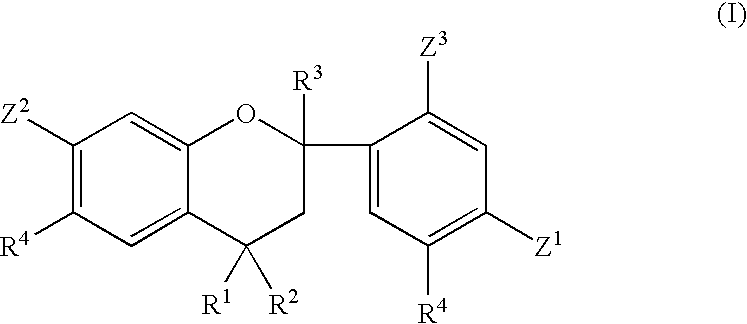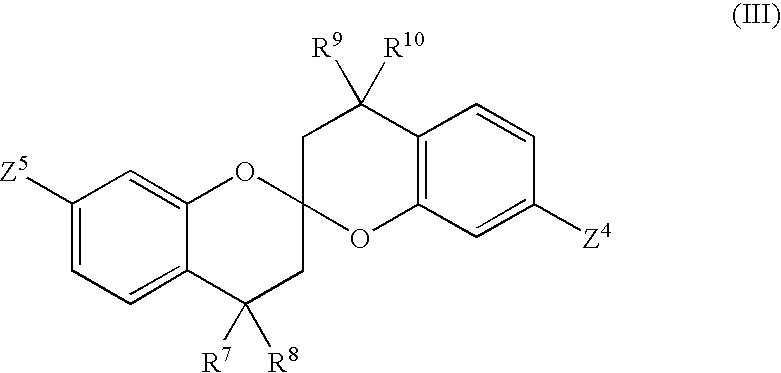Phosphate ester flame retardants from resorcinol-ketone reaction products
- Summary
- Abstract
- Description
- Claims
- Application Information
AI Technical Summary
Problems solved by technology
Method used
Image
Examples
example 1
[0085] Resorcinol (1486.5 grams, 13.5 moles), 37% HCl (444 grams, 4.5 moles) and water (1500 ml) were charged into a 5 L round-bottom flask with a mechanical stirrer, thermometer, addition funnel, and reflux condenser. The contents were stirred and heated to 50° C. Acetone (261.5 grams, 4.5 moles) was added drop-wise for 1.5 hrs. The temperature was increased to 60° C. and held for 3 hours. The product was filtered, water washed, and dried, resulting in 609.5 grams of white powder. Analysis indicated 91 (area) % of 2,4,4-trimethyl-2′,4′,7-trihydroxy flavan compound in the reaction product.
examples 2-7
[0086] Following the synthesis procedure used in Example 1, flavan compounds developed using different molar ratios of resorcinol; acetone, water (solvent) and hydrochloric acid (catalyst) are shown in Table 1.
TABLE 1Ex. 2Ex. 3Ex. 4Ex. 5Ex. 6Ex. 7ReactantsResorcinol (mole)1.01.54.08.010.00.9Acetone (mole)1.00.54.08.05.00.337% HCl (mole)0.40.61.23.21.90.3Water (g)10024070014001100100Reaction ConditionsAcetone Addition50444955na50Temp. (° C.)Reaction Temp. (° C.)5044495420-2550Product (g)110.334.9337.3721.8531.617.4NMR analysis (Area %)Flavan Structure7396.376759398
na = Not Applicable
[0087] From the results of Examples 2 through 7, higher purity flavan compounds could 5 be synthesized from the resorcinol and acetone reactions. These flavan compounds can be employed directly to synthesize the phosphate ester compounds according to embodiments of the invention.
Synthesis of Phosphate Ester of Resorcinol Flavan Compound
[0088] The phosphate ester compound was synthesized using dipheny...
example 8
[0091] The flavan compound of Example 1 (215.0 grams, 0.7 mole), diphenyl 20 chlorophosphate (97.6%; 539.4 grams, 1.96 moles), and methylene chloride (2.0 L) were charged in a 5 L round-bottom flask with a mechanical stirrer, thermometer, addition funnel, reflux condenser with a CaCl2 tube, and heating mantle. The contents were stirred at 35-40° C. A solution of triethylamine (99.5%; 199.3 grams, 1.96 moles) dissolved in methylene chloride (800 ml) was added drop-wise for 2.6 hrs at 35-40° C. The temperature was maintained for an additional 4 hours. The mixture was water washed seven times at 35° C. The methylene chloride was removed at 95° C. using a rotary evaporator (28″ Hg vacuum). The product (679.2 grams) was a yellow semi-solid. A 13C-NMR analysis indicated 82 mole % aromatic C—O—P carbons and 18 mole % (aromatic C—OH carbons+resorcinolic ether carbons), consistent with the desired product. The product contained 9.1 wt. % phosphorus, had a viscosity of 580 cps at 100° C., and...
PUM
| Property | Measurement | Unit |
|---|---|---|
| Reaction temperature | aaaaa | aaaaa |
| Reaction temperature | aaaaa | aaaaa |
| Temperature | aaaaa | aaaaa |
Abstract
Description
Claims
Application Information
 Login to View More
Login to View More - R&D
- Intellectual Property
- Life Sciences
- Materials
- Tech Scout
- Unparalleled Data Quality
- Higher Quality Content
- 60% Fewer Hallucinations
Browse by: Latest US Patents, China's latest patents, Technical Efficacy Thesaurus, Application Domain, Technology Topic, Popular Technical Reports.
© 2025 PatSnap. All rights reserved.Legal|Privacy policy|Modern Slavery Act Transparency Statement|Sitemap|About US| Contact US: help@patsnap.com



